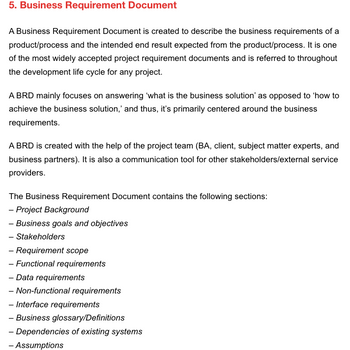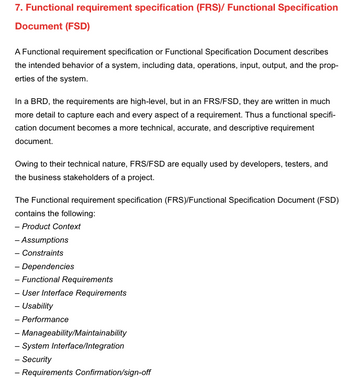
Database System Concepts
7th Edition
ISBN: 9780078022159
Author: Abraham Silberschatz Professor, Henry F. Korth, S. Sudarshan
Publisher: McGraw-Hill Education
expand_more
expand_more
format_list_bulleted
Question
- What are the main differences between a BRD and FSD? What elements make them different from each other?
- Do you think BRD and FSD differs for an agile development methods

Transcribed Image Text:5. Business Requirement Document
A Business Requirement Document is created to describe the business requirements of a
product/process and the intended end result expected from the product/process. It is one
of the most widely accepted project requirement documents and is referred to throughout
the development life cycle for any project.
A BRD mainly focuses on answering 'what is the business solution' as opposed to 'how to
achieve the business solution,' and thus, it's primarily centered around the business
requirements.
A BRD is created with the help of the project team (BA, client, subject matter experts, and
business partners). It is also a communication tool for other stakeholders/external service
providers.
The Business Requirement Document contains the following sections:
- Project Background
- Business goals and objectives
- Stakeholders
- Requirement scope
- Functional requirements
- Data requirements
- Non-functional requirements
- Interface requirements
- Business glossary/Definitions
-Dependencies of existing systems
- Assumptions

Transcribed Image Text:7. Functional requirement specification (FRS)/ Functional Specification
Document (FSD)
A Functional requirement specification or Functional Specification Document describes
the intended behavior of a system, including data, operations, input, output, and the prop-
erties of the system.
In a BRD, the requirements are high-level, but in an FRS/FSD, they are written in much
more detail to capture each and every aspect of a requirement. Thus a functional specifi-
cation document becomes a more technical, accurate, and descriptive requirement
document.
Owing to their technical nature, FRS/FSD are equally used by developers, testers, and
the business stakeholders of a project.
The Functional requirement specification (FRS)/Functional Specification Document (FSD)
contains the following:
- Product Context
- Assumptions
- Constraints
- Dependencies
- Functional Requirements
- User Interface Requirements
- Usability
- Performance
- Manageability/Maintainability
- System Interface/Integration
- Security
-
Requirements Confirmation/sign-off
Expert Solution
This question has been solved!
Explore an expertly crafted, step-by-step solution for a thorough understanding of key concepts.
Step by stepSolved in 2 steps

Knowledge Booster
Similar questions
- Compare the Prince and the Scrum Agile methodologies by answering the following questions:A) Critically analyse the philosophy of each methodology, how each methodology works, what type of projects they serve best and why.arrow_forwardWhat distinguishes agile techniques from more traditional ones? What features of these two approaches are similar and different?arrow_forwardWhat kinds of systems are most suited to agile development?arrow_forward
arrow_back_ios
arrow_forward_ios
Recommended textbooks for you
 Database System ConceptsComputer ScienceISBN:9780078022159Author:Abraham Silberschatz Professor, Henry F. Korth, S. SudarshanPublisher:McGraw-Hill Education
Database System ConceptsComputer ScienceISBN:9780078022159Author:Abraham Silberschatz Professor, Henry F. Korth, S. SudarshanPublisher:McGraw-Hill Education Starting Out with Python (4th Edition)Computer ScienceISBN:9780134444321Author:Tony GaddisPublisher:PEARSON
Starting Out with Python (4th Edition)Computer ScienceISBN:9780134444321Author:Tony GaddisPublisher:PEARSON Digital Fundamentals (11th Edition)Computer ScienceISBN:9780132737968Author:Thomas L. FloydPublisher:PEARSON
Digital Fundamentals (11th Edition)Computer ScienceISBN:9780132737968Author:Thomas L. FloydPublisher:PEARSON C How to Program (8th Edition)Computer ScienceISBN:9780133976892Author:Paul J. Deitel, Harvey DeitelPublisher:PEARSON
C How to Program (8th Edition)Computer ScienceISBN:9780133976892Author:Paul J. Deitel, Harvey DeitelPublisher:PEARSON Database Systems: Design, Implementation, & Manag...Computer ScienceISBN:9781337627900Author:Carlos Coronel, Steven MorrisPublisher:Cengage Learning
Database Systems: Design, Implementation, & Manag...Computer ScienceISBN:9781337627900Author:Carlos Coronel, Steven MorrisPublisher:Cengage Learning Programmable Logic ControllersComputer ScienceISBN:9780073373843Author:Frank D. PetruzellaPublisher:McGraw-Hill Education
Programmable Logic ControllersComputer ScienceISBN:9780073373843Author:Frank D. PetruzellaPublisher:McGraw-Hill Education

Database System Concepts
Computer Science
ISBN:9780078022159
Author:Abraham Silberschatz Professor, Henry F. Korth, S. Sudarshan
Publisher:McGraw-Hill Education

Starting Out with Python (4th Edition)
Computer Science
ISBN:9780134444321
Author:Tony Gaddis
Publisher:PEARSON

Digital Fundamentals (11th Edition)
Computer Science
ISBN:9780132737968
Author:Thomas L. Floyd
Publisher:PEARSON

C How to Program (8th Edition)
Computer Science
ISBN:9780133976892
Author:Paul J. Deitel, Harvey Deitel
Publisher:PEARSON

Database Systems: Design, Implementation, & Manag...
Computer Science
ISBN:9781337627900
Author:Carlos Coronel, Steven Morris
Publisher:Cengage Learning

Programmable Logic Controllers
Computer Science
ISBN:9780073373843
Author:Frank D. Petruzella
Publisher:McGraw-Hill Education